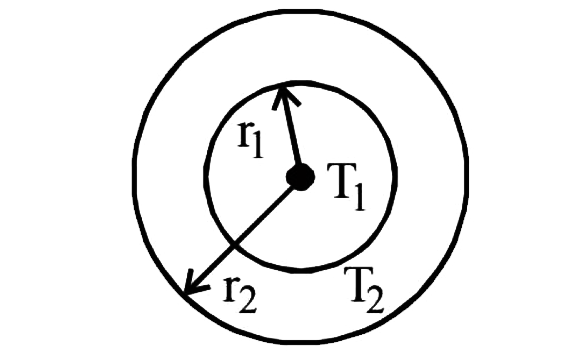Find the temperature distribution in a substance palced between two parallel plates kept at temperatures T1 and T2. The plate separation is equal to l, the heat conductivity coefficient of the substance x¯¯¯¯¯¯∝V¯¯¯T.
Q=k∂T∂x=−A√T∂T∂x
=−23A∂T3/2dx,(A=constant)
=23A(T3/21−T3/22)l
Thus T3/2=constant−xl(T3/21−T3/22)
or using T=T1 at x=0
T3/2T3/21+xl(T3/22−T3/21) or (TT1)3/2=1+xl((T2T)3/2−1)
T=T1[1+xl{(T2T1)3/2−1}]2/3.
Topper's Solved these Questions
- BOOK - IE IRODOV, LA SENA & SS KROTOVCHAPTER - THERMODYNAMICS AND MOLECULAR PHYSICSEXERCISE - Phase Transformations35videos
THERMODYNAMICS AND MOLECULAR PHYSICS
- BOOK - IE IRODOV, LA SENA & SS KROTOVCHAPTER - PHYSICAL FUNDAMENTALS OF MECHANICSEXERCISE - Relativistic Mechanics49videos
PHYSICAL FUNDAMENTALS OF MECHANICS
Similar Questions
Find the temperature distribution in a substance placed between two parallel plates kept at temperatures T1 and T2. The plate separation is l. The heat conductivity coefficient λ varies with temperature as 1/√T.
View SolutionFind the temperature distribution in the space between two coaxial cylinders of radii R1 and R2 filled with a uniform heat conducting substance if the temperatures of the cylinders are constant and are equal to T1 and T2 respectively.
View Solution
Knowledge Check
- Question 1 - Select One
The efficiency of an ideal heat engine working between the temperatureT1 and T2(T1>T2) is
A1−T1T2B1−T2T1C1+T2T1DT2T1 - Question 2 - Select One
χ1 and χ2 are susceptinilities of diamagnetic substance at temperatures T1K and T2K respectively. Then
Aχ1T1=χ2T2Bχ1=χ2Cχ1√T1=χ2√T2Dχ1T2=χ2T1 - Question 3 - Select One
The figure shows a system of two concentric spheres of radii r1andr2 are kept at temperature T1andT2, respectively. The radial rate of flow of heat in a substance between the two concentric spheres is proportional to
 AIn(r2r1)Br2−r1r1r2C(r1−r2)Dr1r2r2−r1
AIn(r2r1)Br2−r1r1r2C(r1−r2)Dr1r2r2−r1
A uniformly distributed space charge fills up the space between two large parallel plates separated by a distance d. The potential difference between the plates is equal to zero ? What will then be the field strength near the other plate ?
View SolutionOne end of a rod, enclosed in a thermally insulating sheath, is kept at a temperature T1 while the other, at T2. The rod is composed of two sections whose lengths are l1 and 12 and heat conductivity coefficients x1 and x2. Find the temperature of the interface.
View SolutionA heat flux passes through a gas from a heated plate with a temperature T1 to a cold plate with a temperature T2 . The linear dimensions of the plates are large compared to the distance between them. Is the temperature gradient the same along the entire heat flux? Why when measuring the thermal conductivity coefficient must we place the plates horizontally, with the plate with the higher temperature placed above the one with the lower temperature?
View SolutionA rof of length l with thermally insulated lateral surface consists of material whose heat conductivity coefficient varies with temperature as x=α/T, where α is a constant. The ends of the rod are kept at temperatures T1 and T2. Find the function T(x), where x is the distance from the end whose temperature is T1, and the heat flow density.
View SolutionThe quantity of heat which can rise the temperature of xgm of a substance through t∘1C can rise the temperature of ygm of water through t∘2C is same. The ratio of specific heats of the substances is
View Solution

